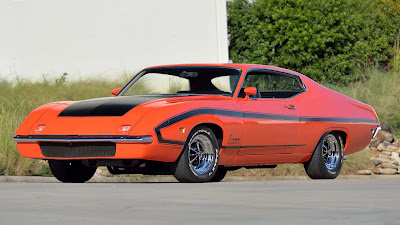Unlucky BEAST - In the world of automotive history, it’s a rare occurrence for prototype vehicles to escape the crusher, but the 1970 Torino King Cobra is an exceptional survivor. This remarkable car, one of only three ever built by Ford as a NASCAR aero special, has withstood the test of time for nearly half a century. Back in the late 1960s, the excitement of NASCAR's "Aero Wars" saw Ford and Chrysler fiercely competing with cars that deviated from the usual designs seen in the showrooms.
 |
| The 1970 Torino King Cobra is an astonishing example of a muscle car that was ready for production but ultimately didn’t make it. (Picture from: Mecum) |
Of the three Torino King Cobras, this particular one stands out as the only model equipped with a 4-speed transmission. By 1970, the NASCAR aero wars had reached a peak with the introduction of sleek-nose and winged models like the Charger Daytonas and Plymouth Superbirds. The Ford Torino King Cobra Prototype of 1970 is an astonishing example of a muscle car that was ready for production but ultimately didn’t make it. While it never hit the production lines, its legacy lives on in automotive history and perhaps even in the digital realms of games like GT6 or GT7.
 |
| The 1970 Torino King Cobra, designed by Larry Shinoda, features a long, sloped front end for the restyled 1970 Torino, intended as a successor to the blunt-nosed 1969 Torino Talladega. (Picture from: GTPlanet) |
The fierce rivalry between Ford and Chrysler led to the development of big wings and sloped noses on cars like the Chargers, Torinos, and Cyclones. This competition gave birth to the Torino King Cobra, as Ford aimed to counter Mopar’s aerodynamic edge. Ford designer Larry Shinoda was tasked with creating a long, sloped front end for the restyled 1970 Torino, a potential successor to the 1969 Torino Talladega with its blunt nose.
 |
| The 1970 Torino King Cobra was adorned with blackout hood treatment, side stripes, and "King Cobra" fender decals. (Picture from: Mecum) |
To prepare for homologation as a street car, the Calypso Coral prototype was adorned with blackout hood treatment, side stripes, and "King Cobra" fender decals. However, an executive shake-up at Ford led to the company pulling out of racing, leaving the King Cobra project without a purpose and eventually shelving it quietly.
 |
| The 1970 Torino King Cobra's interior remains purposefully spartan, featuring a bench seat and Hurst shifter, maintaining its original black finish. (Picture from: Mecum) |
Beneath its race-bred aerodynamic package, the King Cobra houses a powerful 429 V8 engine with a Holley four-barrel carburetor, paired with a Toploader four-speed transmission, and also features an aluminum dual-plane intake. All of these combinations produced an impressive 700 horsepower.
 |
| The 1970 Torino King Cobra houses a powerful 429 V8 engine with a Holley four-barrel carburetor, paired with a Toploader four-speed transmission, and also features an aluminum dual-plane intake. (Picture from: Mecum) |
Power is transmitted to a Ford 9-inch rear end, with handling managed by the Torino’s stock double A-arm front suspension and heavy-duty leaf-sprung rear. Despite being a prototype, the King Cobra’s interior is well-equipped, utilizing many standard Torino features. The project's original aim was to develop a competitive NASCAR car, but due to budget cuts by Ford President Lee Iacocca and restrictions on large engines, the project was canceled.
 |
| The 1970 Torino King Cobra also features with a unique convex glass rear window, original CarLite glass stamped "prototype development," and "prototype" lettering on the back of a door panel and the gauge housing. (Picture from: GTPlanet) |
Originally, this King Cobra was powered by a 429 Cobra Jet engine, but it has since been upgraded to a Boss 429, Ford’s NASCAR engine of the era. The interior remains purposefully spartan, featuring a bench seat and Hurst shifter, maintaining its original black finish. This exceptionally rare 1970 King Cobra is documented with a copy of the bill of sale from Ford to Bud Moore.
 |
| The 1970 Torino King Cobra, with its storied past and rare existence, continues to capture the imaginations of automotive enthusiasts. (Picture from: GTPlanet) |
Instead of facing destruction, two of the King Cobras, including this one, were delivered to Ford’s race team, Bud Moore Engineering, in 1971. Eventually, Moore sold this particular orange King Cobra, which was later rediscovered in a South Carolina field. An extensive restoration has brought the car back to its original prototype condition, including its unique convex glass rear window, original CarLite glass stamped "prototype development," and "prototype" lettering on the back of a door panel and the gauge housing.
 This Torino King Cobra, with its storied past and rare existence, continues to capture the imaginations of automotive enthusiasts. Its journey from a fierce competitor in the "Aero Wars" to a rediscovered gem serves as a testament to the enduring allure of classic American muscle cars. *** [EKA | FROM VARIOUS SOURCES | MECUM | MOTOR1 | MOTORTREND | GTPLANET | ULTIMATECARPAGE ]
This Torino King Cobra, with its storied past and rare existence, continues to capture the imaginations of automotive enthusiasts. Its journey from a fierce competitor in the "Aero Wars" to a rediscovered gem serves as a testament to the enduring allure of classic American muscle cars. *** [EKA | FROM VARIOUS SOURCES | MECUM | MOTOR1 | MOTORTREND | GTPLANET | ULTIMATECARPAGE ]Note: This blog can be accessed via your smart phone

